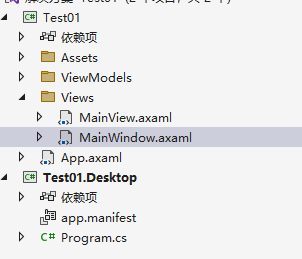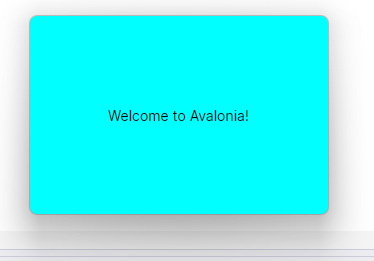Avalonia桌面如何自定义边框
001 Avalonia 桌面如何自定义窗口边框
版本 Avalonia 11.0.0
0. 资料来源
- AvaloniaUI(二、无边框窗口) https://www.cnblogs.com/wuyaxiansheng/p/17584413.html
1. 前言
我在进行桌面开发的时候总是很在意如何进行桌面的边框自定义,以及在使用其他软件的时候,也会留意这件事,我没有接触UWP的原因之一也是因为UWP似乎始终用的是那种风格的边框,毕竟这也是曾经给Surface等等触摸设备做的嘛,也没有什么办法。
总之这篇文章将会提供自定义边框的各种API,以及边框效果的对比。
文章会在最后有省流无脑示例代码
本文有两种推荐的方法,推荐标识有写在文中,这两种比较总之我非常滴喜欢。
2. 在 Avalonia 中的 Window 对象
WPF中的一些经验在 Avalonia 中不太适用。自定义窗口边框的主要操作对象是 Avalonia 的 Window 对象,我的项目叫做 Test01, 请在 Test01/Views/MainWindow.axaml 的地方找到对应的 axaml 文件吧,注意它不在 Test01.Desktop 这个项目里面。

为了方便教程里面的截图,我刻意的改了尺寸和背景颜色,具体代码如下,对于各位来说没有什么影响。
<Window x:Class="Test01.Views.MainWindow"
xmlns="https://github.com/avaloniaui"
xmlns:x="http://schemas.microsoft.com/winfx/2006/xaml"
xmlns:d="http://schemas.microsoft.com/expression/blend/2008"
xmlns:mc="http://schemas.openxmlformats.org/markup-compatibility/2006"
xmlns:views="clr-namespace:Test01.Views"
xmlns:vm="using:Test01.ViewModels"
Title="Test01"
Width="300"
Height="200"
Background="Aqua"
Icon="/Assets/avalonia-logo.ico"
mc:Ignorable="d">
<views:MainView />
</Window>

3. API 介绍
注意:Avalonia 将自定义窗口边框成为 ClientArea 的 Extended 拓展,为了容易理解,本文姑且将这种概念笼统且不准确地称之为大家更容易理解的边框。
当然,我会保留英文原文。
1. Window.ExtendClientAreaToDecorationsHint 属性(强烈推荐之一)
class Window
{
// 读取或设置用户内容区是否可以挤到标题栏(虽然翻译的看起来不对,但是粗暴的理解的话,这会更好懂一些hh)。
// Gets or sets if the ClientArea is Extended into the Window Decorations (chrome or border).
public bool ExtendClientAreaToDecorationsHint {get;set;}
}
这个属性居然不是 Is 开头,这让我一时半会还不太相信这个属性的功能。
这个属性是用来控制用户内容是否能挤到标题栏的,如果换一种视角的话,也就是让标题栏的那些内容被下放到用户内容区似乎。
默认的情况下 ExtendClientAreaToDecorationsHint = false。
当 ExtendClientAreaToDecorationsHint = true 的时候是下面这样的。

你可以和上一张图做对比,可以肉眼发现,标题栏和内容融为一体了,但是注意,标题内容和 Icon 被吃掉了呢。
2. Window.ExtendClientAreaChromeHints 属性
// 对于边框样式的类型的描述
// Hint for Window Chrome when ClientArea is Extended.
[Flags]
public enum ExtendClientAreaChromeHints
{
// 没有边框
// The will be no chrome at all.
NoChrome = 0,
// 使用系统边框
// Use SystemChrome
SystemChrome = 1,
// 平台默认
// The default for the platform.
Default = 2,
// 优先尝试使用系统边框,在 OSX 中使用 OSX 的边框样式,在 Windows 中使用 Windows 的边框样式。
// 这是因为 Windows 的边框样式无法显示在用户内容上面(我读不懂原文是什么意思)。
// Use system chrome where possible. OSX system chrome is used, Windows managed
// chrome is used. This is because Windows Chrome can not be shown on top of user
// content.
PreferSystemChrome = 2,
// 在 OSX 上,标题框将会是一个更细的工具栏标题框,
// 标题栏三色的按钮的位置会比普通样式的要肉眼可见的低一点。
// On OSX the titlebar is the thicker toolbar kind.
// Causes traffic lights to be positioned slightly lower than normal.
OSXThickTitleBar = 8
}
class Window
{
// 可设置或读取 Avalonia.Platform.ExtendClientAreaChromeHints 来设置边框到底长什么样。
// Gets or Sets the Avalonia.Platform.ExtendClientAreaChromeHints that control how the chrome looks when the client area is extended.
public ExtendClientAreaChromeHints ExtendClientAreaChromeHints {get;set;}
}
Avalonia 中的 Window 具有 ExtendClientAreaChromeHints 属性,值类型是枚举 ExtendClientAreaChromeHints ,这个枚举类型具有 [Flag] 特性,说明可能其中的一些特性可以叠加使用。
注意:只使用 ExtendClientAreaChromeHints 是没有什么用的,这需要别的属性参与使用,也就是需要开启 ExtendClientAreaToDecorationsHint = true。
2.1 无边框(强烈推荐之二)
ExtendClientAreaChromeHints="NoChrome"
ExtendClientAreaToDecorationsHint="True"

在讨论窗口有无边框的时候,窗口是否拖拽也是值得纳入的参考。在设置为 NoChrome 时,这个窗口是可以拖动的。
2.2 默认
ExtendClientAreaChromeHints="Default"
ExtendClientAreaToDecorationsHint="True"

这就是仅 ExtendClientAreaToDecorationsHint = true 开启时候的样子了,也很好看。
3. Window.ExtendClientAreaTitleBarHeightHint
描述标题栏的高度属性,标题栏的高度决定标题栏可拖动的地方的多寡。
class Window
{
// 设置标题栏高度。
// -1 的话表示系统默认。
// 其它正数可以影响标题栏的高度。
// Gets or Sets the TitlebarHeightHint for when the client area is extended.
// A value of -1 will cause the titlebar to be auto sized to the OS default.
// Any other positive value will cause the titlebar to assume that height.
public double Window.ExtendClientAreaTitleBarHeightHint { get; set; )
}
如果不希望它能拖拽,那就设成 0 吧。
4. Window.SystemDecorations
// 系统边框的样子
// Determines system decorations (title bar, border, etc) for a Avalonia.Controls.Window
public enum SystemDecorations
{
// 没有边框
// No decorations
None = 0,
// 没有标题栏
// Window border without titlebar
BorderOnly = 1,
// 全部都有
// Fully decorated (default)
Full = 2
}
4.1 没有标题栏
这个窗口很大,而且 Window 的 Width 和 Height 也失效了,我本来是设置的很小的一个。
SystemDecorations="BorderOnly"

4.2 空样式
这个东西非常理想。但是拖拽无效,但是也很合理,这种就很标准了。
SystemDecorations="None"

3. 如何背景透明
直接将背景 Background 设置成 Transparent 是一种非常不错的选择。
Background="Transparent"
SystemDecorations="None"

4. 省流示例
<Window x:Class="Test01.Views.MainWindow"
xmlns="https://github.com/avaloniaui"
xmlns:x="http://schemas.microsoft.com/winfx/2006/xaml"
xmlns:d="http://schemas.microsoft.com/expression/blend/2008"
xmlns:mc="http://schemas.openxmlformats.org/markup-compatibility/2006"
xmlns:views="clr-namespace:Test01.Views"
xmlns:vm="using:Test01.ViewModels"
Title="Test01"
Width="300"
Height="200"
Background="Transparent"
SystemDecorations="None"
Icon="/Assets/avalonia-logo.ico"
mc:Ignorable="d">
<Grid>
<Border Margin="20"
Background="White"
BoxShadow="0 5 20 4 #33000000"
CornerRadius="10" />
<views:MainView />
</Grid>
</Window>





 浙公网安备 33010602011771号
浙公网安备 33010602011771号